Is Israel-Hezbollah War Imminent?; Yemeni Government Proposes Plan to Neuter Houthis; Iran Proxies Strike U.S. Bases
As worldwide attention fixates on the seesaw negotiations for an Israel-Hamas ceasefire and hostage release in Gaza, the “war in the north” between Israel and Hezbollah appears to be on the verge of exploding into a full conflict, with airstrikes and attacks being exchanged between the two sides on an almost hourly basis. French and U.S. negotiators are offering a plan for an Israeli-Hezbollah ceasefire that would require Hezbollah to withdraw its troops from the border zone, something neither Hassan Nasrallah or the Iranian Supreme Leader appear ready to do.
For many on the Israeli side, unless Hezbollah withdraws to positions that cannot threaten northern Israel, a full-on war to destroy Hezbollah is inevitable, even if that risks war with Tehran as well. The Biden administration hopes to stave off this scenario through French mediation in Beirut, but Israeli patience for formulas that rely on the Lebanese government constraining Hezbollah is running thin. The White House is likely to find itself with another major war on its hands unless it decides once and for all to exert enough actual pressure to deter Tehran and Hezbollah so that the “Axis of Resistance” ceases its attacks against Israel, U.S. troops, and American allies. The Biden administration’s penchant for “de-escalation” rather than pressure toward Iran so far has resulted in regional war rather than the quiet National Security Advisor Jake Sullivan and others in the White House long for.
Far to the south, the Iranian regime’s proxy offensive against international shipping in the Red Sea and Gulf of Aden shows no sign of ending, despite U.S.-led coalition airstrikes against Houthi targets. In fact, the Houthis are performing their function as Tehran’s dispensable proxies, absorbing the brunt of U.S. retaliation as the U.S. administration leaves their IRGC sponsors untouched.
As the U.S. and its allies cast about for solutions to the Houthi/IRGC threat that don’t involve war with Tehran, Yemen’s recognized government in Aden is offering its services in leading a renewed campaign against the Houthis on the ground. Having fought the Houthis to a standstill for several years, the Yemeni government proposes that with renewed international and Arab support, it could ramp up pressure on Houthi-held territory, including the port of Hodeidah–which the Houthis rely upon to survive and which a Yemeni government operation nearly seized in 2019. With the toll on the global economy rising and U.S. airstrikes insufficient to stop Houthi attacks so far, international leaders may find the Yemeni government offer too good to dismiss without serious consideration.
Back in Gaza, as Ramadan approaches there is not yet a deal agreed among the U.S., Egypt, Qatar, Israel, and Hamas for a ceasefire and release of hostages. And regardless of any such deal, there is no sign that the Israeli government or public is ready for a permanent ceasefire that would leave Hamas in a position to still pose a threat to Israeli territory. It’s likely that the Israeli public will not be satisfied with the Gaza campaign before seeing the IDF destroy the remaining Hamas forces burrowed beneath Rafah, regardless of Ramadan or any other consideration. Consequently, the only feasible quick end to the conflict in Gaza would be through a Hamas surrender and demobilization, something neither Hamas leaders nor their Iranian regime patrons are yet willing to do.
The bottom line is that the ceasefire deal currently being negotiated in Cairo is unlikely to resolve the conflict or stop its spread but may only extend it. The responsibility of the Israeli government extends to ensuring the safe return of all hostages. But the key to ending the cycle of violence lies in Hamas’s hands: releasing the hostages, surrendering, and agreeing to legal accountability would be decisive steps toward ending the war and relieving the Palestinian people’s suffering. The path to ending this conflict and its atrocities fundamentally lies with the decisions of Hamas.
==================
★ ISRAEL & PALESTINIAN TERRITORIES
Gaza Operations Continue; New Palestinian Government in the Offing?
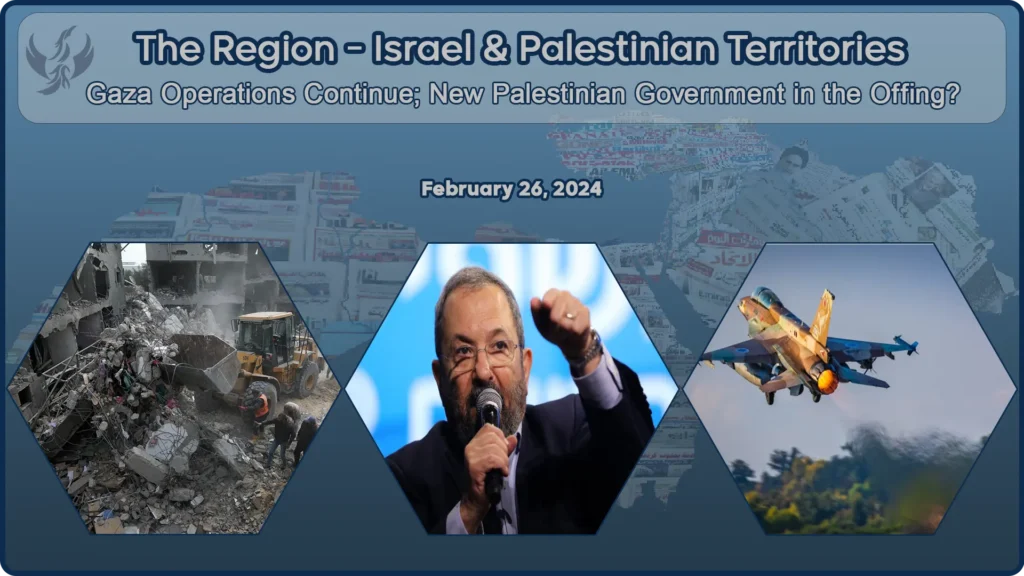
The recent narrative on the Israel-Hamas conflict highlights the complexity and persistent challenges in achieving peace. Last week’s developments saw the Israeli army conducting targeted attacks in Rafah, despite ongoing talks of a ceasefire and a full ground incursion. Contrasting reports emerged about the Nassar Hospital; Israeli sources claim aid and a generator were provided before withdrawal, while Arabic media reported significant damage, underscoring the divergent narratives from both sides. This discrepancy highlights the deep information warfare accompanying the conflict.
The internal political divisions within Israeli and Palestinian communities further complicate the prospects for peace, suggesting a disconnect between public representations of peace and the actual feasibility of such an outcome. The humanitarian crisis deepens, with reports of Palestinians in refugee camps resorting to slaughtering horses for food, and the unresolved status of hostages taken on October 7, indicating the severe ongoing human toll on both societies.
Chronology:
On February 19, Hamas fires a rocket from Gaza into an open area in Kibbutz Be’eri, prompting the Israeli Defense Forces (IDF) to retaliate. The IDF quickly identifies the launch site, and an Israeli Air Force (IAF) aircraft strikes, neutralizing the assailant. Israeli sources also report the elimination of additional armed terrorists near IDF troops. Additionally, the IDF demolishes a residential complex near the Khan Yunis refugee camp, conducts extensive operations in Gaza City’s Zeytoun neighborhood, and actively engages in the Shejaiya neighborhood.
The next day, the IDF launches attacks across the Gaza Strip, targeting a building near Hassan Albana Mosque in Nuseirat and a civilian vehicle in Rafah. Naval forces target the coast of Deir al-Balah. In Rafah, multiple strikes, including on Nasser Abu A-Nur’s house, result in 22 deaths. The IDF also carries out additional attacks in Deir al-Balah and the Zeitoun neighborhood of Gaza City. They attack a residential complex in Khan Yunis. Rafah experiences at least eight attacks, notably on the Alfaroq Mosque in the Shavora neighborhood, among other residential targets, leading to three deaths.
On February 21, the IDF carries out a targeted strike in the Zalata area, east of Rafah, affecting the Abu Ma’amr and Abu Mazouk families. At the same time, in separate operations in Jenin, the IDF and ISA jointly eliminate Yasser Hanoun, linked to several shooting attacks against Israeli communities and military posts. They target Hanoun while he is on his way to carry out another attack. The next day, the IDF and ISA intelligence announce the precise operation they conducted yesterday, was to eliminate Islamic Jihad terrorist Yasser Hanoun, implicated in multiple shooting attacks against Israeli communities and soldiers. During a second operation, the IDF neutralizes three Qassam Brigades operatives and arrests 14 suspects. Gazans circulate a video showing an IDF vehicle moving unchallenged along Al Bahar Street in Khan Yunis, indicating IDF control and a significant reduction in Hamas military presence in the area.
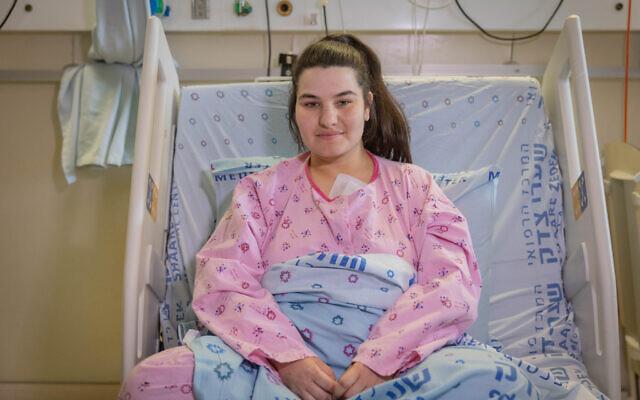
A series of events unfolds across Israel and Gaza, starting with night attacks in Rafah on Wednesday, February 21. Eight strikes target the Alfaroq Mosque in the Shavora neighborhood and five residences, resulting in 23 deaths. On the same day, three gunmen from Bethlehem carry out a terror attack near a Jerusalem checkpoint, killing one Israeli man and injuring 11 others, including a pregnant woman. IDF forces kill two of the attackers and capture one. Additionally, Elbit Systems unveils the Hermes 650 Spark UAS, designed for medium altitude long endurance missions. IDF operations in Gaza claim 22 lives in Deir al-Balah and Rafah, targeting Hamas facilities and smuggling tunnels. The IDF also criticizes the Hamas leadership through the distribution of “Aluaqa” magazine.

Arab channels reports that hours after announcing a new operation in northern Gaza’s Zaytoun area, the Israeli army reports three serious incidents: the death of a Nahal Brigade officer and three soldiers with serious injuries. Details emerge of a close-range confrontation with Hamas, an anti-tank missile hitting an armored vehicle, and a half-ton bomb detonation alongside another missile attack. Hamas claim fierce battles resulted in Israeli casualties, employing close-range devices and RPGs against vehicles and soldiers, and noted drone activity for evacuating the dead and wounded. Since October 9, the Israeli army has reported 575 military casualties, including 23 since the ground operation began.
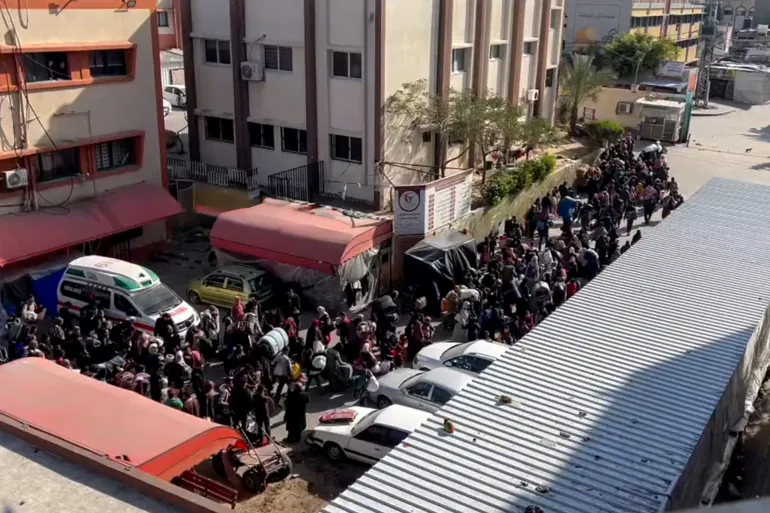
On February 23, the IDF wraps up a targeted operation against Hamas, detaining around 200 suspects, discovering weapons, and finding items indicating the identities of hostages. The operation aims to minimize disruptions at Nasser Hospital by providing humanitarian aid and maintaining essential services. This operation triggers contrasting narratives between Israeli and Palestinian sources, with the latter reporting significant impacts on hospital functionality and civilian welfare.
Israel becomes Azerbaijan’s top oil importer in January 2024, a topic of discussion during a meeting between Israeli and Azerbaijani presidents at the Munich Security Conference.

On February 24, political shifts in Israel show the opposition leading with 67 seats to the coalition’s 44 in a Lazar Research poll, amidst ongoing Gaza conflict and complex hostage negotiation dynamics. Nearly half of respondents prefer Benny Gantz over Benjamin Netanyahu as prime minister. Amidst these political dynamics, Finance Minister Bezalel Smotrich criticizes the proposed hostage deal as “delusional,” while Prime Minister Netanyahu reportedly hardens his negotiation terms.
The Palestinian Ministry of Health announces that more than 100 Palestinians were killed in Israeli raids on the Gaza Strip over the course of 4 hours, and television indicated that an Israeli drone bombed a school belonging to the United Nations Relief and Works Agency for Palestine Refugees (UNRWA) near Nuseirat in central Gaza, while eight people were also killed and wounded. Others in an Israeli raid targeted a house east of Rafah, bringing the death toll since the beginning of the war to about 2,954, in addition to wounding about 70 others.
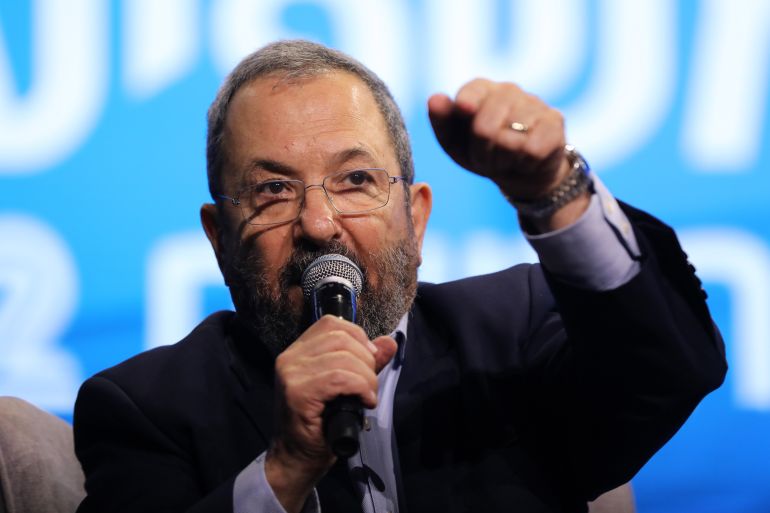
On February 25, Former Prime Minister Ehud Barak urges demonstrators to besiege the Knesset, calling for 30,000 citizens to gather outside the government building for three weeks to pressure Prime Minister Benjamin Netanyahu. Barak asserts that Netanyahu’s time is up and that there is zero trust in him, emphasizing the need for early elections in Israel. He criticizes Netanyahu’s policies, particularly regarding a prisoner exchange deal, warning of the country sinking into a “Gaza quagmire.” Barak accuses Netanyahu and his allies of obstructing Israel’s security interests and dragging the country into chaos. Additionally, Barak expresses concern about the ongoing conflict with Hamas in Gaza, highlighting the devastating toll on civilian lives and the risk of worsening the situation.
The proposed US-Israel-Egypt-Qatar talks, a deal for Hamas to release 40 hostages for a six-week ceasefire and Israel to free Palestinian prisoners is discussed, amid skepticism from Israeli officials, including Finance Minister Bezalel Smotrich.
An Israeli team heads to Qatar for negotiations, focusing on hostages, including three French nationals, and ceasefire efforts to aid Gaza. Concerns arise over Netanyahu’s stringent conditions potentially derailing talks, with demands for expelling released terrorists to Qatar and verifying hostage statuses.
The IDF conducts airstrikes in Rafah, southern Gaza Strip, resulting in the deaths of 7 members of the Yahya Shahin family. Another attack targets the Al Khatib family’s house near a supply center but caused no casualties due to prior evacuation. The Air Force also struck a smuggling tunnel shaft near the border and an ammunition depot placed by Hamas near the Philadelphia axis.
Conversely, Al Jazeera reports that the Ministry of Health in Gaza announced that the Israeli army committed 7 massacres killing 90 people and wounding 131 others. A viral story about the dire circumstances in the Jabalia refugee camp, a 60-year-old refugee slaughtering his two horses, previously used for agricultural work, to provide sustenance for his family and the surrounding community.
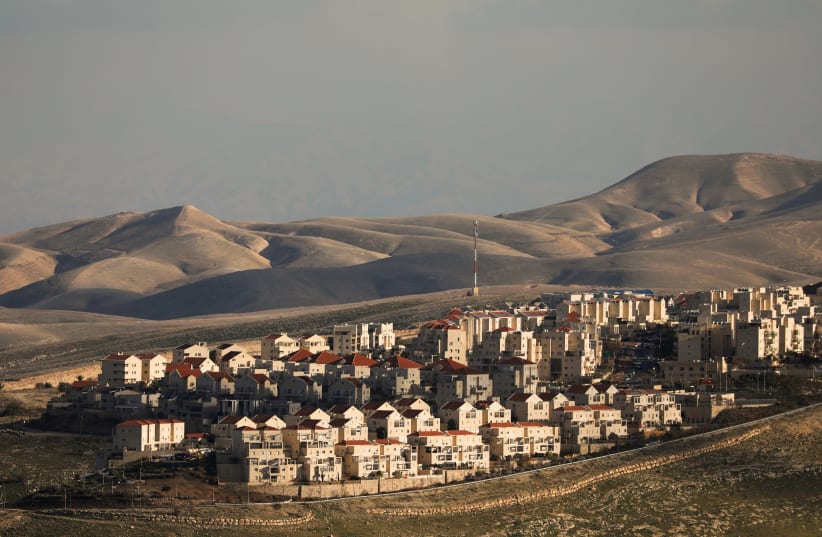
The IDF plans to evacuate Palestinian civilians and target Hamas in Gaza’s Rafah, alongside efforts to prevent looting. Prime Minister Netanyahu asserts the operation is vital for defeating Hamas, with the conflict expected to conclude within weeks. Despite global condemnation, Netanyahu emphasizes the necessity of the Rafah operation for Israel’s victory. Discussions on a potential hostage release deal with Hamas could delay the operation, with ongoing negotiations involving Israel, Egypt, and Qatar. Israel rejects Hamas’s ceasefire demands, focusing on a deal to exchange Palestinian prisoners for hostages. The U.S. has stressed the importance of protecting civilians in any military actions in Rafah.
Israeli officials report significant progress in Paris ceasefire talks, reducing gaps with Hamas, yet challenges remain, as Hamas demands a ceasefire, Israeli withdrawal, and aid introduction, conditions not yet met according to Israel.
The War Cabinet assesses the situation, indicating optimism but acknowledging Hamas’s demands exceed Israel’s current stance.
Israeli Prime Minister Benjamin Netanyahu insists that high-profile Palestinian prisoners, specifically those jailed for attacks against Israelis, be sent to Qatar as part of a Gaza ceasefire and hostage deal. This demand, yet to be discussed with mediators, aims to differentiate between prisoners based on the severity of their offenses. The negotiation complexities are further highlighted by disputes with Hamas over the exchange terms and the grim revelation of the death of an Israeli soldier held captive, underscoring the tension and stakes involved in reaching an agreement.
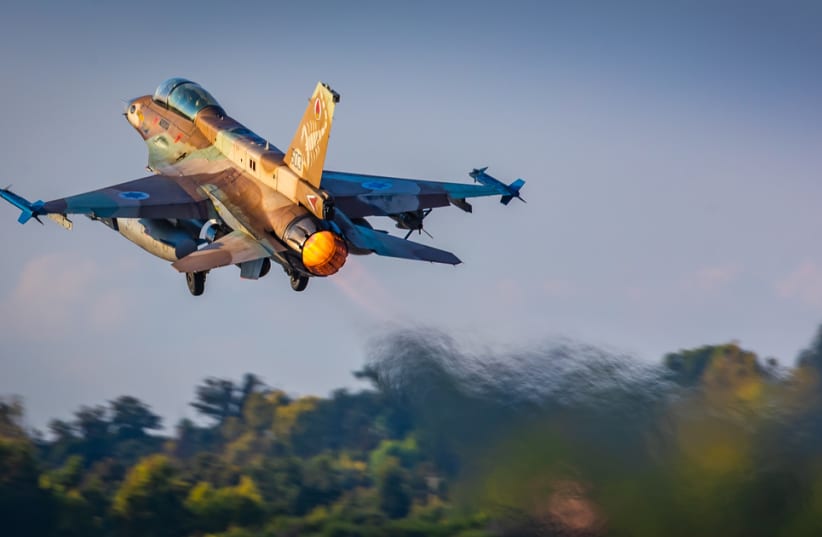
The Israeli Air Force, led by Maj.-Gen. Tomer Bar, establishes an Iran department to address Iran’s increasing threat, particularly regarding its nuclear ambitions and regional terrorist activities. This move underscores Israel’s readiness for potential conflicts and signals the seriousness of the Iranian threat to the United States. The department is tasked with ongoing operations to counter Iranian influence and secure against Iran-backed groups, despite internal challenges from reservists protesting against governmental reforms, highlighting the importance of maintaining readiness and adaptability.
During a World Trade Organization conference in Abu Dhabi, Economy Minister Nir Barkat engages in discussions with Saudi Commerce Minister Majid bin Abdullah Al-Qasabi, expressing optimism about potential cooperation between Israel and Saudi Arabia.

One hopeful story emerges in the midst of this war about the University of Haifa, whose multicultural student body of Jews, Arabs, and Druze distributed orange wristbands bearing “Continuing to Learn Together” to symbolize unity and learning beyond politics. This initiative, emerging from a challenging selection process for a slogan and color, underscored the university’s commitment to inclusion and resilience. The campus’s proactive approach to address the needs of its diverse students, including resilience groups and workshops, alongside the dedication to maintain a harmonious and safe educational environment, showcases a model of coexistence and mutual understanding.
On February 25, divergent narratives emerge from the Israeli Defense Forces (IDF) and Al Jazeera regarding military activities in the Gaza Strip and the West Bank. The IDF reports the arrest of Jamil Nabhan, an officer in the Palestinian National Security, in Jenin, West Bank, and detailed attacks in the Gaza Strip, specifically in Gaza City’s eastern parts and Beit Hanoun. This action is part of a broader operation that included the surrounding of a building in Harsh al-Saada in Jenin with reinforcements.
In contrast, Al Jazeera’s coverage focuses on what it described as the “142nd day of the Israeli aggression on Gaza,” highlighting intense conflicts between Palestinian resistance forces and Israeli troops in Khan Yunis’s Al-Zaytoun neighborhood, in the southern part of the Gaza Strip. The report mentions a “continuing violent bombardment” on Gaza City neighborhoods, resulting in approximately 90 fatalities in a single day. Al Jazeera also reports on the Israeli military’s operations inside Nasser Hospital in Khan Yunis and broadcasts exclusive footage of battles in Khan Yunis, showcasing the targeting of Israeli soldiers and military vehicles by the Al-Qassam Brigades, the military wing of Hamas. This footage includes the use of anti-personnel and anti-armor shells, as well as the detonation of barrel bombs near Israeli military vehicles.
Palestinian Prime Minister Muhammad Shtayyeh resigns amid talks of restructuring the Palestinian Authority, emphasizing a competency-based future government, per Fatah spokesman Abdel Fattah Dawla. The resignation, pending President Mahmoud Abbas’s decision, signals a push for reform and national consensus during an Israeli blockade and the need for unity in addressing Gaza’s situation. Hamas opposes a technocratic government at the same time that the U.S. pushes for technocratic reform. The U.S. initiative conflicts with Israel’s stance against empowering the current Palestinian Authority in Gaza. The official spokesman for Hamas, Jihad Taha, denies that there had been discussions about forming a new Palestinian government, stressing that the present time should focus on stopping “the Israeli aggression.”
Hamas responds to the video of Gazans protesting against them by stating that ongoing ceasefire negotiations are difficult. These voices, according to Hamas, stem from the severe Israeli bombing, hunger, and lack of aid. In an interview with Al-Arabiya/Al-Hadath on Sunday, a spokesperson adds that the voices speaking against Hamas in Gaza might be fabricated, arguing that it is Israel, not Hamas, that has caused the people’s suffering, and thus protests should be directed at Israel. The spokesperson also mentions that Israel blames the Palestinian people for the war and goes on to criticize the ineffective peace talks.
IDF’s initial probe into the death of 6-year-old Hind Rajab and her family in Gaza City suggests no IDF troops were in the vicinity. Despite accusations, the IDF claims no responsibility, citing lack of forces near the scene.
In a harrowing act of protest against the Gaza war, Aaron Bushnell, a 25-year-old active-duty U.S. Air Force pilot, set himself on fire in front of the Israeli embassy in Washington D.C. Bushnell’s protest, aimed at drawing attention to the “genocide” in Gaza, was broadcast live over the Internet. Despite immediate intervention by the Secret Service, Bushnell later died from his injuries.
==================
★ ISRAEL & Hezbollah
Israel Extends Operations Deeper into Lebanon & Syria
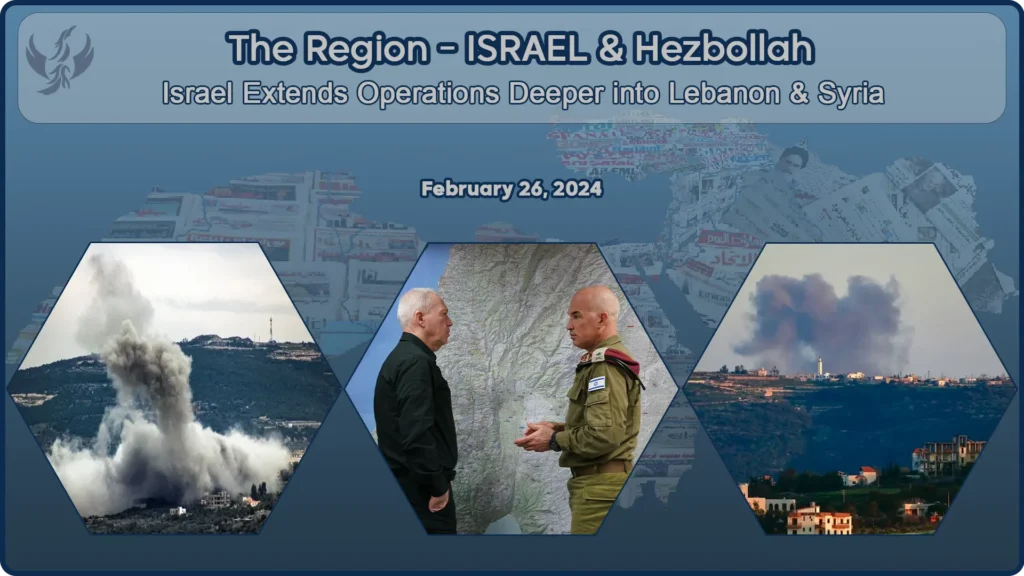
During last week, Israel conducted 43 operations against Hezbollah and related targets in Lebanon and Syria. The operations ranged from airstrikes on buildings and infrastructure to intercepting missiles aimed at Israeli UAVs. The extensive number of operations conducted by Israel indicates a high operational tempo aimed at degrading Hezbollah’s military capabilities, disrupting its infrastructure, and targeting its personnel. Israel’s target selection indicates a precise approach to weakening the military and logistical support structures of Hezbollah. This also indicates Israel’s intelligence capabilities in identifying and striking such targets.
Hezbollah’s actions included at least 4 operations against Israeli targets, including a drone incident near Tiberias, a strike on the “Ma’ale Golan” facility, two suicide drones towards Kiryat Shmona, and a rocket and drone strike at Galilee. These Hezbollah operations reflect a strategy of defensive posturing and limited retaliatory actions.
Chronology:
On February 19, the IDF launches attacks in southern Lebanon, including a drone strike on a vehicle in the village of Eazia, Sidon Governorate, located a full 50 km from the Israel border, injuring 8. The IDF Spokesman announces they are targeting weapon warehouses in Sidon in response to a Hezbollah drone falling in Israeli territory near Tiberias, resulting in 14 injuries, predominantly among Syrian and Palestinian workers.
A Lebanese Almanar channel reporter details the IDF’s operations for the day, up to 6:00 p.m., including strikes in Albastan, Kfar Yaroun, two in Meiss El Jabal, two in Al Adisa, and multiple bombings in the industrial area of Eazia, Sidon. In the last hour, the IDF is actively attacking in Meiss El Jabal, Belida, and Khula.
On February 20, IDF fighter jets target several Hezbollah terror sites in Lebanon. They strike the village of Belida in southern Lebanon three times, destroying several houses. IDF soldiers also hit two rocket launch sites in Yaroun and Marwahin, as well as more terrorist infrastructure in Dhayra and Yaroun. Additionally, they target two military structures in Houla and Blida.
On February 21, the IDF targets a location in the village of Jabeh, in the Tafah district, deep within Lebanese territory. Concurrently, the IDF strikes the Kfarsusa area of Damascus, hitting a building used by IRGC-affiliated elements.
Shortly after, the IDF attacks in Khiam, southern Lebanon. Another Israeli attack targets multiple sites in the Dimas area, northwest of Damascus, marking the second assault there today.
Assad regime sources report the activation of Syrian air defense systems in an attempt to intercept the attack, suggesting the intelligence for the operation might have been inaccurate.
Al Manar reports an attack in Majdal Zoun (Almanzouri), resulting in the deaths of a woman and a girl. Additional attacks include one in Khiam, one in Marwahin, and two in Ayta Ash Shab.
Up to this point, Hezbollah claims responsibility for 12 attacks against Israeli targets on February 21 alone, with 3 of these attacks described as “responses” to the IDF’s actions against civilians, civilian homes, and villages in southern Lebanon.
On February 22, the Israeli Air Force strikes the area of Kfar Raman, northern Nebatieh, approximately 30 km from the Israeli border. A building in Raman is hit by an Israeli drone, leaving two dead and three wounded. Two Hezbollah members are killed in an earlier attack in Kfar Rumman: Hassan Saleh, a senior commander known as Haj Gafar, and Sham Abdullah, a military operative, bringing Hezbollah’s total battle deaths since October 8th to 208.
Hezbollah reports casualties from an IDF attack the previous night in Belida, southern Lebanon, that Hezbollah claims targeted a “medical center.” In retaliation, Hezbollah strikes the Israeli “Ma’ale Golan” facility. The IDF attack in Belida results in three deaths: Muhammad Ismail, Hossein Khalil, and Muhammad Traf, a military activist, increasing Hezbollah’s death toll to 211.
In response to the Belida incident, Hezbollah launches two suicide drones at 09:30 towards the headquarters of the Regional Council in Kiryat Shmona inside Israel.
On February 23, Israeli warplanes target the home of the Shami family in Kafrkela, adjacent to the building of the Islamic Medical Authority (affiliated with Hezbollah – AA). The attack completely destroys the property, reportedly without causing any casualties.
On February 24, Hezbollah releases footage of a missile it claims struck the window of the IDF’s 769th Brigade headquarters in Kiryat Shmona on February 22nd, showing a dummy on the attacked building’s roof.
The IDF Spokesperson reports that an IDF aircraft spotted a terrorist cell entering a Hezbollah weapons storage facility in Matmoura. Shortly after, IDF fighter jets target the facility, causing secondary explosions from the large weapon quantities stored there.
IDF fighter jets also strike a Hezbollah operational command center in Baraachit, along with launch posts and terrorist infrastructure in Jabal Blat, southern Lebanon. Additionally, IDF artillery responds to a threat in Rachaya Al Foukhar, leading to significant destruction from the previous night’s IDF attack in Baraachit.
On February 25, an Israeli drone targets a Hezbollah truck near the Al-Kazir area in Homs, Syria, close to the Lebanon border, resulting in the deaths of Ahmed Elafi and Hossein Dirani. This brings Hezbollah’s deaths since the war’s outset to 214.
Shortly thereafter, Hezbollah operative Ali Nasser is killed in an IDF attack in Belida, southern Lebanon, marking casualty number 215.
Kiryat Shmona becomes a focal point for Hezbollah’s retaliations as Israel conducts a second raid on Blida, southern Lebanon. The Israeli army announces it targeted firing sites and infrastructure of Hezbollah in the Jabal Balat area.
On Sunday, three Israeli raids hit Belida, with Israel pledging to intensify strikes on Hezbollah, even during potential truces in Gaza.
Hezbollah responds by firing rockets and a drone at Galilee, as Israeli jets continue to pound southern Lebanon. Al Jazeera reports an Israeli government plan to evacuate 60,000 Israelis from northern Galilee, while Defense Minister Yoav Gallant threatens increased bombings until Hezbollah “surrenders.”
Hezbollah leader Hassan Nasrallah advises his militia and their families in the south to stop using their phones so as to avoid targeting by the IDF. He also sends his daughter to meet Supreme Leader Khamenei in Tehran, possibly in response to Khamenei’s directive for Tehran’s proxies to exercise strategic patience and avoid escalating tensions with Israel.
Amos Hochstein, a White House mediator, has paused his efforts to resolve Israel-Hezbollah tensions pending Lebanon’s response to a French de-escalation plan that would impose a ceasefire and Hezbollah’s military withdrawal from specific areas.
Today, Monday February 26, Israel launches airstrikes in Baalbek in Lebanon’s northern Bekaa Valley, targeting a Hezbollah facility on Baalbek’s outskirts. These strikes result in three Hezbollah fatalities and four injuries, including a Lebanese army member and his son. Additionally, Israel targets a site in Al-Tuffah Province, South Lebanon, and a vehicle in the Tyre district, killing one person. The IDF employs its David’s Sling system to intercept a surface-to-air missile launched from Lebanon. The missile aimed at an IDF “Zik” type UAV, which was not damaged and continued its mission. Later, an additional missile launch succeeds in shooting down the UAV inside Lebanese territory.
==================
★ The Houthis
Yemeni Government Volunteers to Deter the Houthis
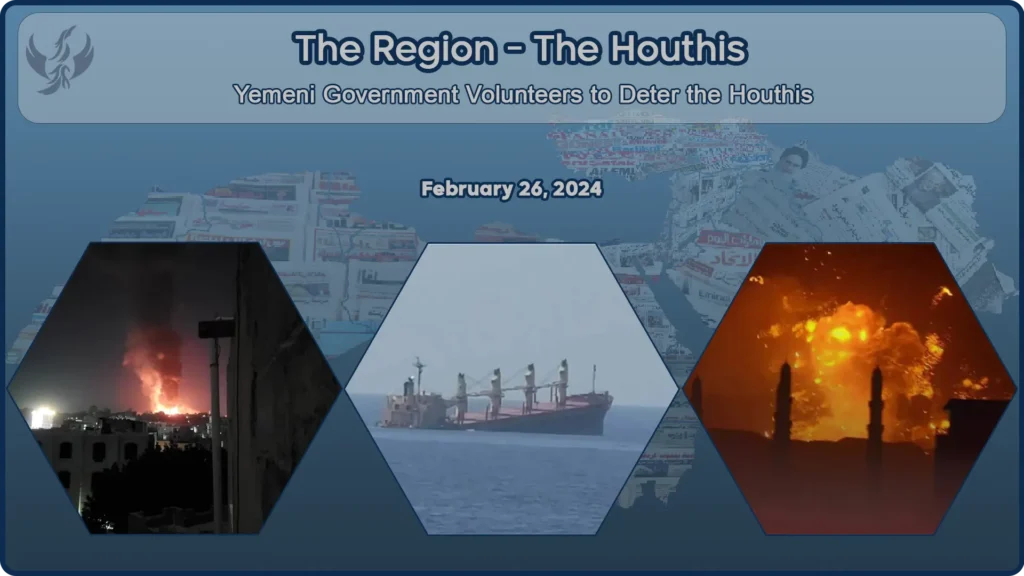
Although the Houthi movement claims its months-long offensive against international shipping is motivated by the Gaza conflict, the Houthis’ track record shows they constituted a threat to vessels in the Red Sea and Gulf of Aden long before October 7th. In 2022, the Houthis reportedly committed 504 maritime violations, including 183 instances of targeting commercial and military ships, 49 instances of weapon smuggling from Iran, 17 attacks on Saudi and Yemeni ports, the deployment of 192 mines, and 63 assaults on fishermen.
While the Biden administration has been hesitant to confront Iran directly over Tehran’s proxy offensive against international shipping, Yemeni specialists propose viable alternative strategies drawing on historical successes in counterterrorism efforts against groups like ISIS. The Yemeni government is proposing a unified approach to combat Houthi terrorism, emphasizing the necessity of a political, rather than military, response from international powers such as the U.S., UK, and EU. Utilizing their influence within the UN Security Council, Yemeni government leaders suggest supporting Yemen’s recognized government and allies to maintain maritime security, enforce international law, and implement UN Security Council Resolution 2216, which includes designating the Houthis as terrorists. This strategy also involves operations to liberate Hodeidah and protect vital sea lanes, with the near-recapture of Hodeidah port in 2019 serving as a testament to the potential success of such initiatives.
Chronology:
On February 19, Houthis launch an attack on the British-owned ship Rubymar near the port of Al Mukha, close to the Bab al Mandab strait. They fire a series of missiles, causing the vessel to halt in the Gulf of Aden, with an imminent risk of sinking. The ship’s crew receives authorization from the Houthis to evacuate safely. Concurrently, the Houthis successfully down an American MQ9 Reaper drone.
Meanwhile, the translation of a video featuring Israel’s Transport Minister discussing the inland goods bridge from India through the United Arab Emirates, Saudi Arabia, and Jordan to Israel stirs controversy. The translation into Arabic provokes a backlash, drawing significant criticism from Palestinians and their supporters, who express their displeasure with a barrage of colorful curses.
On February 20 and 21, the Houthis intensify their offensive operations in the Red Sea and the Arabian Sea, targeting several American ships with unmanned aerial vehicles (UAVs). They also launch UAV attacks towards the Israeli seaport of Eilat, although the target remains outside Israeli territory, ensuring no civilian threat.
The Houthis escalate their maritime aggression by firing several missiles at the Israeli ship MSC SILVER. Meanwhile, the British ship Rubymar, previously attacked by the Houthis in the Gulf of Aden, begins sinking. Meanwhile, the British Maritime Trade Organization reports a fire onboard another vessel, located 70 nautical miles southeast of Aden, following a Houthi missile attack.
The United States Central Command reveals environmental repercussions from the Houthis’ attack on the Rubymar, including an 18-mile oil slick and the release of harmful fertilizers into the sea.
On February 24, Yemeni media outlets report that American and British forces have conducted airstrikes targeting the northern neighborhoods of Sana’a, Yemen’s capital.
On February 25, the US-led coalition, involving the UK and supported by Bahrain, Canada, the Netherlands, Australia, Denmark, and New Zealand, launches strikes against 18 Houthi locations, including arms and missile depots, UAV facilities, air defense systems, radars, and a helicopter. Al-Mayadeen, a Lebanese channel, reports a total of 22 strikes across Sana’a, Hajjah, and Taizz provinces.
In retaliation, the Houthis attack the American oil tanker Torm Thor with missiles and deploy drones against American warships. However, the US Central Command confirms that these attacks cause no damage or casualties. Footage circulates of an American F/A 18 Super Hornet taking off from an aircraft carrier, tasked with striking Houthi targets.Al Jazeera reports that the Houthis acknowledge a toll of one killed and six injured from an American-British bombing in Taiz Governorate. Despite the coalition strikes, the Houthis vow to continue to block Israeli ships. Iran condemns the American and British strikes, which Tehran claims will escalate regional tensions and widen the scope of war. Iranian Foreign Ministry spokesman Nasser Kanaani criticizes the United States and Britain for fueling conflict and instability in the region.
==================
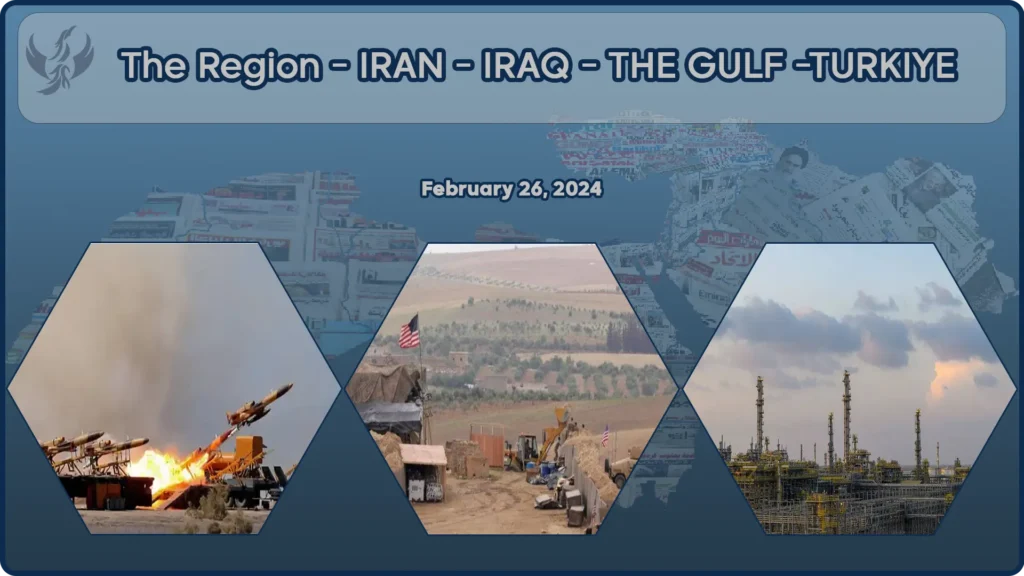
★ IRAN
Iran’s Global Arms Trafficking Is Increasing
Recent events indicate the Iranian regime has stepped up its weapons developments and its arms trafficking in conflicts in several regions. Accused by western powers of being a global arms supplier, Iran denies selling ballistic missiles to Russia for use in the Ukraine conflict. Despite these denials, Iran has reportedly enhanced its military cooperation with Russia and has recently unveiled new air defense systems, signaling an expansion of its arms industry.
The U.S. also expresses concerns over Iran’s weapon shipments to the Sudanese army amidst ongoing conflict, emphasizing the need for a focus on restoring civilian rule and addressing the humanitarian crisis in Sudan.
Additionally, The ballistic missile development efforts of Iran are advancing within the confines of the underground Islamic Revolutionary Guard Corps (IRGC) Chamran Air Base, situated near Jam. Analyzing terrain features showcased in their propaganda videos has exposed the existence of operational silos for the Qiam-1 missile and provided insights into the base’s internal layout.
Finally, against the backdrop of U.S.-led airstrikes against the Houthis, the U.S. Department of Justice has charged four individuals linked to a vessel intercepted by the U.S. Navy, which was found carrying Iranian weapons destined for the Houthis in Yemen. This operation, conducted on January 10, also tragically resulted in the deaths of two American soldiers from the Navy’s elite forces. The seized ship, crewed by the four accused, was carrying Iranian-made missile components en route to the Somali coast.
This incident underscores the Houthi’s ongoing efforts to acquire more sophisticated weaponry from Iran, as American and Western intelligence reports have highlighted the Houthis’ intentions to escalate attacks, including targeting cargo ships. The discovery has raised concerns over the Houthis’ plans to attack Western forces in the region, though the impact of recent U.S. military actions in Yemen on these plans remains uncertain.
==================
★ SYRIA
Iranian-Affiliated Groups Target American Bases Daily
The Syrian Observatory for Human Rights confirms ACLS’s report on simultaneous attacks on U.S. bases in Syria on February 20, 2024. Iranian-affiliated groups have escalated attacks since the year began, with 54 strikes, notably on the Al-Omar and Conoco oilfields. On February 26, explosions in Deir ez-Zor signal another attack on the Conoco gas plant by Iranian-backed groups, with no casualties reported. February 25 saw similar attacks on the Conoco plant. On February 24, missiles hit the Al-Omar oil field during American training. The Syrian Observatory reports explosions near Al-Omar oil field on February 22, coinciding with American aircraft patrols near Iranian positions. The Iranian-sponsored attacks are supposedly in retaliation to Israeli actions in Gaza since October 7.
Recent explosions south of Deir ez-Zor injured over 10, including non-Syrians, at pro-Iranian sites. This surge in hostilities follows a year with 67 attacks in 2023, including a deadly drone strike on January 28 that killed three Americans and injured 25.
==================
★ THE GULF
Saudi Arabia’s Energy Sector Breakthrough
Saudi Aramco’s discovery of new gas reserves in the Jafoura field marks a pivotal development, with the new reservoir of 15 trillion cubic feet of gas and two billion barrels of condensate elevating the field’s reserves to 229 trillion cubic feet of gas and 75 billion barrels of condensate. The discovery positions Saudi Arabia as a potential leader in the global natural gas market, underscoring the Kingdom’s strategic shift towards energy diversification and gas exportation. Recognized as the Middle East’s largest shale gas field, Jafoura is central to Saudi Arabia’s plan to transition to lower emissions and cleaner fuel. Additionally, Saudi Arabia’s commitment to launching 20 gigawatts of renewable energy projects by 2024, targeting 50% electricity from renewables by 2030, highlights its broader environmental strategy. These developments are expected to bolster Saudi Arabia’s economic diversification and enhance its long-term energy revenue.
==================
★ TURKIYE
Erdoğan Eyes Victory in Key Municipal Elections
On February 26, 2024, President Recep Tayyip Erdoğan mobilized the AK Party’s election team in Ankara, aiming for victory in the March 31 municipal elections. Despite previous losses in key cities, Erdoğan hopes to regain urban strongholds by criticizing the opposition’s self-serving motives. The Turkish political scene has intensified, especially in Istanbul, where Mayor Ekrem Imamoglu of the CHP is facing off against AK Party’s Murat Kurum. The Turkish opposition’s support is fragmenting, with former allies like the Good Party and the People’s Democratic Party presenting their own candidates alongside the CHP. As a result, there is a de facto opposition/AKP alliance against Imamoglu that will endanger his re-election. Political analyst Murat Yetkin frames the situation as not only a test for Imamoglu but a reflection of broader political dynamics in Turkey, where the outcome could reshape the political landscape, highlighting the internal opposition’s role as much as voter sentiment.



